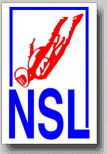Up Close & Personal
name: Dan Brodsky-Chenfield
email: DanChenfld@aol.com
age: 63
education: Ohio State University - graduated with a major in aviation and a minor in theater.
family & marital staus: Married (Kristi) with children (five-year old Chloe Layne, one-year old Landen)
number of jumps: 15,000
years in Sport: 45
teams: Greene County Fusion 1983-1987, Coolidge Force 1989-1991, Perris Air Moves 1992-1993, Arizona Airspeed 1994-1999
slot(s): Point with Fusion, Rear Center ever since.
favorite competition: All the ones that were neck and neck all the way to the finish.
funniest moment in skydiving: Too many to pick one.
skydiving mentor(s): James Layne and Chet Poland. Anyone that knew them would know why. They were always constant reminders to live life to its fullest every day. Get the most from every second.
hobbies: Playing with my kids.
favorite book(s): "Illusions" by Richard Bach
favorite music: Anything rock and roll, mostly the older stuff.
favorite place: Apache Lake Arizona and home
Where will you be ten years from now? Involved with the development and public awareness and exposure of Formation Skydiving, taking a POPS team to medal at the U.S. Nationals (that could be in three years)
best kept secret: I'm not telling now.
favorite quote:
"I look forward to the day when our sport is publicly recognized and financially supported. But neither of these gains would have made my competition career any more worth while. Just more comfortable. The personal challenges that this sport offered me were worth every penny and every sacrifice. I wouldn't trade them for anything."
- Dan Brodsky-Chenfield
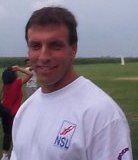
Dan Brodsky-Chenfeld is his real name, many friends keep it short with just "BC". However, he is one of the most experienced competitors and coaches in the history of Formation Skydiving, a living legend. His story is as exciting as can be, a fairytale of skydiving with all ups and downs imaginable. BC has been a role model for every competitor, no matter on which level. He is motivating and encouraging skydivers to build teams and experience the same excitement and challenges he has been through. His ideas and visions of the future of skydiving are perfectly matching the NSL vision. When NSL reporter Kurt Gaebel interviewed BC this summer, he was fascinated by BC's stories and thoughts. The interview was not that easy to do since BC is a busy man, even though he is not on the actual Airspeed schedule anymore. As a coach, his motivation to work with his customers is neverending. He has done this thousands of times already, and he still sounds as if each participant means everything to him. Finally, an early-morning country-style breakfast gave both BC and Gaebel the chance to find some quiet time for the story. The result was the most interesting NSL Profile.

The Begining
Although BC has become part of Skydive Arizona's inventory, it all started in Ohio. BC's first team was the "Greene County Fusion". Fusion and BC went to the U.S. Nationals for the first time in 1983. After 150 training jumps, Fusion ended up on 7th place beating one of the famous Mirror Image 4-way teams. BC had just over 1000 jumps by then. In 1984 he graduated from Ohio State University with a major in aviation and a minor in theater. Prepared with these degrees for a career, he decided to move in a completely different direction. BC started working at his home drop zone Greene County Skydiving in Ohio. By the way, Greene County Skydiving is host for the third season meet of the Great Lakes Skydiving League 2000. BC finally took over the DZ in 1984. He stayed there and continued training with Fusion until 1987. At the U.S. Nationals in 1986, Fusion was tied with the Golden Knights on second place at the end if the meet. The teams did two jump off rounds and stayed tied until it was called.
The Move
In 1988, BC felt the urge for a move. Many different reasons motivated him to leave Ohio. He knew that he wanted to do hard core 4-way on a full-time basis. At that time, there were actually two options to pursue his main goal: there was Tom Piras with his DeLand Gang in Florida, and the other option was waiting at the west coast. The west coast did not really offer anything concrete to BC; however, it is where history was made by Mirror Image and the Visions and where the Gumbies were still skydiving. Piras was busy coaching the French TAG team and jumping with 4n Legion. He had asked BC earlier to help him with the coaching job. However, Piras and Florida did not attract him enough, so in the summer of 1988, BC went west.
The Contact
He was on his own, but he had the desire and his goals. If nothing would be there, he would initiate something. BC drove his old van, which would be his new home for a while, through the whole country and stopped in Coolidge on his way to California. There he met Larry Hill for the first time who was running the skydiving operation in Coolidge at that time. Hill had already his vision of creating a world training center for teams by then. When BC met local hot shot Jim Hotze the next day, things began to get exciting for BC. Hotze already had a team set up, including Jeff Root and a German fellow, but he kept talking with BC about 4-way in Coolidge. Both wanted to do a full-time 4-way team. Larry Hill wanted to accommodate such a project. Although BC was on his way to the heart of the west coast skydiving at that time, Perris Valley, his visit in Coolidge left a deep impression on him. Before he left, Hotze and BC agreed to make a few jumps two weeks later.
The Check
BC moved on to California to meet the famous Perris Gumbies. BC was friends with them and had hoped to get his project started together with them. The Gumbies trained on the weekends and had already five members. BC was asking them to pick the best 4-way of these six people and go full-time. Unfortunately, the Gumbies decided to continue as a weekend team. This was not enough for BC. Although the few jumps they made together in Perris during his visit were the best ones of his life by then, things did not materialize the way he had hoped for. He decided to go back to Coolidge and start from scratch with the young kids who had never competed before at the U.S. Nationals.
Coolidge - The Fource
Back in Coolidge, "The Fource" was still one member short. BC remembered his buddy Mike Traad who used to fly for him as a jump pilot in Ohio. Traad was on his way to move to Arizona for college. Traad had only 300 jumps but was eager to join BC and the "The Fource". Jeff Root and Jim Hotze had just below 1000 jumps total each. BC was already by far the most experienced skydiver of the group with his 3500 jumps at that time. The first training weekend came up with Mark Price filming the team. The score was not too promising with a 6.0 average at that time, but they all knew that this was only the beginning. One year later, they would score 13.0 average at the U.S. Nationals 1989 to win the bronze medal. The Fource had completed 800 jumps by then. The "Golden Knights" won the 4-way event in 1989, "Deland Heat and Air" with Jack Jefferies placed second. Heat and Air went to the World Championship in Spain since the Golden Knights decided to compete only in 8-way at the world meet. In 1990, George Jicha replaced Jeff Root. The Fource made 250 training jumps and placed third again behind the Golden Knights and the "Deland Gang". In 1991, Larry Hill moved his whole operation from Coolidge to Eloy. The Fource moved, as well. There were no personell changes from 1990 to 1991, which made 1991a most promising year. At the U.S. Nationals this year, BC's greatest success was as close as could be. After six rounds, The Fource was four points ahead of the DeLand Gang with arch rival Tom Piras when disaster struck. The Fource lost nine points in one jump due to three penalties. The gold medal was history, the DeLand Gang went to the world meet.

Perris - Air Moves
The same year, BC began writing a story for a movie. His idea for a skydiving movie was and is specifically one for an "Athletic Drama", like Rocky or Breaking Away. He had and has his vision and a plan of a theme that would be a compliment to the sport and hopefully lead to the recognition that the NSL is working towards, as well. It was not related in any way to "Action Adventure". BC finished the screenplay in 1991. Now, BC was looking for new challenges again, and for a place where he could begin selling the movie. Melanie Conatser of Perris Valley was planning to build a new full-time team at her place. She contacted BC asking if he was interested in picking the right people for this new team project. The offer came just at the right time. BC thought that he would be in the right place in Perris to train and make his movie happen. Thus, Conatser did not have to twist BC's arm, although he had to leave Larry Hill in Eloy for a while. Again, BC did not pick experienced skydivers. Another old buddy from Ohio was the number one pick. James Layne had started skydiving at the age of 14 years with BC coaching him. BC had always been impressed by his talent. Troy Widgery, another of his best friends, followed BC's invitation to Perris. The three of them tried a few new people. Tom Falzone finally made the slot, Richard Stuart became team videographer. The "Perris Air Moves" was born in 1992. BC was not new to the business anymore as with his first project in Coolidge. Now he knew exactly how to do it right. The training was more progressive and productive. The Air Moves started as low as with 9.0 average. It took them 300 jumps to get up to 15.0 average.
The Disaster
Then, disaster struck again, much worse this time. On April 22, 1992, a full Twinotter load crashed in Perris, going straight into the ground from 200 ft., nose first. Perris Air Moves was on that load, sixteen people were killed in the accident, including Perris staff people, another 4-way team, students and Air Moves member James Layne. BC, Falzone and Widgery miraculously escaped death. So did team videographer Richard Stuart whose camera broke before he entered the plane. The replacing videographer for this jump got killed. This was one of the most tragic days in skydiving history. BC broke his neck, his back, several other bones, his lung had collapsed, and he was unconscious for six whole weeks. When he woke up, he had lost 40 lbs. and did not remember a thing of the accident. His memory stopped one month prior to the accident.
The Comeback
The accident had broken BC physically, but not his desire to live the Air Moves Dream. Most likely, the accident made BC and his team mates appreciate what they had had with the team even more. The desire to win became more a secondary goal at that time. The road they had been on was the most moving part of the Air Moves trip. BC was not willing to give up this dream. He started to work on his recovery, knowing already that Mike Traad would come back to fill the open slot Layne had left behind. As soon as BC got rid of his "halo" (neck brace), his team mates wanted to be ready to pick it up with BC again. BC still had to be careful. One day, he turned his head the wrong way. His whole body went numb. BC had to go back into the hospital for another surgery at the end of August 1992. This time, they placed a metal plate in his neck which remains there today, always reminding him of this time. However, "Magnet Man" Kirk Verner came into the picture filling the slot for BC. This time, Air Moves was in the air while BC was on the ground coaching and helping the team. They had ten weeks with Verner until the Nationals in 1992 and managed to squeeze in 200 training jumps. BC was ready to skydive again the week prior to the competition. He was needed. The young team and the short time for training did not allow the new Air Moves to become comfortable enough with slot switchers. BC would rotate into the training and even into the competition for the rounds where a memory sequence was drawn. At the Nationals in 1992, BC was competing again. He weighed in at 135 lbs and still wore a soft neck brace. The Air Moves won the bronze medal with BC and Kirk Verner competing together in the same team for the first time. Another gold medal went to the east coast with the DeLand Gang and future team mate Jack Jefferies winning the meet. Before the legendary Arizona Airspeed project was to happen, BC had to wait for another year. In 1993, Jack Jefferies called BC in Australia where he was coaching at that time. Jefferies was looking for a new team member for the 1993 season with the World Championship in Eloy, Arizona. as the highlight at the end of the year. The DeLand Gang was qualified, but a shift in the team forced the Gang to look for a new member. BC recommended Kirk Verner for this season. Verner left and stayed in Florida with Jefferies until after the world meet. Meanwhile BC picked up Mark Kirkby and John Hamilton for the Air Moves. Falzone was still on the team for the 1993 season. Again, the Air Moves placed shortly behind the DeLand Gang at the U.S. Nationals.
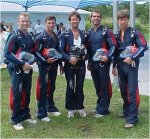
Airizona Airspeed
Then came the big move: at the end of 1993, none of the top competitors in the United States were happy with the situation any longer. When BC and Jefferies talked with each other, they realized that things were out of order. Part of the motivation for forming AirSpeed was that Jefferies was getting tired of being beaten by the French (1989, 1991, 1993), and BC was getting tired of being beaten by someone who was being beaten by the French. Finally, Kirk Verner, who had been competing on both sides, started negotiating the big east-west unification. The result was the most promising team squad: Dan BC, Jack Jefferies, Kirk Verner, Mark Kirkby - the legendary AirSpeed was borne. Still, AirSpeed did not have a home at that time. A decision needed to be made with members from both ends of the country. DeLand and Eloy were both offering. Considering AirSpeed's needs, Skydive Arizona remained as the only choice. AirSpeed would not have been able to train as they wanted and needed to anywhere else. The new AirApeed wanted an environment that would give them the opportunity to successfully pursue their goal: bringing Excalibur and the gold medals back to the U.S.A. BC and Larry Hill rejoined for a new effort in Eloy. In 1995, Arizona AirSpeed beat France by two points. Excalibur returned to the U.S.A. exactly ten years after Tom Piras with his Air Bears had won it the last time. The original plan was made for two years. However, the success made the project become even stronger and the commitment longer. A second 4-way team was included and sponsored. In 1997, the same Airspeed squad defended the world title successfully with France four points behind.

Things changed again after winning the second gold medal in 1997. Sponsor Larry Hill wanted more. The gold medal in 4-way was not enough. He encouraged the team to form a strong 8-way team out of the two 4-ways. BC had not been much into 8-way until then. The challenge to win the gold medal in both events was incredibly high. No other team had ever done this before in the history of Formation Skydiving competition. AirSpeed8 would have the talent and the expertise to take on this challenge. Former Golden Knight 8-way world champion Craig Girard had already joined the AirSpeed project in 1995. 1996 was the begining of the AirSpeed 8-way project. After the world meet in 1997, the priority shifted from 4-way to 8-way. BC was aware of the chance the team was taking. They could win both events. But they could also lose both events. Finally, they got both. In 1998, AirSpeed beat the Golden Knights at the U.S. Nationals to qualify for the World Championship. It was the first defeat for the Golden Knights in 8-way since 1986. AirSpeed won the 4-way event, as well. At the World Championship in 1999, AirSpeed won the gold medal in 8-way. But they were clearly beat by the French 4-way team. Excalibur went back to France.
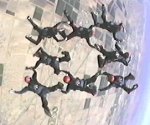
BC has only one regret: he enjoyed the 8-way project and the success of it. However, due to the 8-way commitment, he did not have the chance to push the 4-way to new levels he is still seeing. BC believes that the scoring can go higher than 24-point average. AirSpeed had the potential to go up to 24 if they had only done 4-way from 1994 through 1999. He regrets that he cannot go there himself anymore. So he is trying to push his successors to the new limits. As coaches, friends and AirSpeed consultants, BC and Jefferies are still haunting the new AirSpeed squads: AirSpeed Vertical and Zulu. BC's support and experiences will be very important for the new teams. The competition will be tough again.
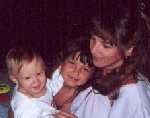
As much as Dan BC has been a successful competitor, he wonders if he had been able to achieve his goals without his wife Kristi. They started seeing each other in late 1990. BC and Kristie were together in California. She was a great help to him when he was injured. BC still doesn't know how he would have handled it without her. 1994 was a big year for BC because that was the first year of AirSpeed. However, it was even bigger because his daughter Chloe Layne was born. Kristi gave birth again to their son Landen in June 1999. Landen was followed by Eliana Metni, Jadyn Verner, and Alexis Hill only a few months later. 1999 was a very fertile year for Skydive Arizona and AirSpeed. The AirSpeed tradition may continue for a long time...
